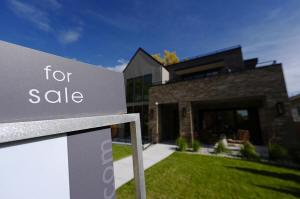Average US rate on a 30-year mortgage edges higher, ending a seven-week
slide
[March 14, 2025] By
ALEX VEIGA
The average rate on a 30-year mortgage in the U.S. edged higher this
week, ending a seven-week slide that helped ease borrowing costs for
home shoppers leading into the spring homebuying season.
The rate averaged 6.65% this week, up from 6.63% last week, mortgage
buyer Freddie Mac said Thursday. A year ago, it averaged 6.74%.
Borrowing costs on 15-year fixed-rate mortgages, popular with homeowners
seeking to refinance their home loan to a lower rate, also ticked up
this week. The average rate rose to 5.8% from 5.79% last week. A year
ago, it averaged 6.16%, Freddie Mac said.
Mortgage rates are influenced by several factors, including bond market
investorsí expectations for future inflation, global demand for U.S.
Treasurys and the Federal Reserveís interest rate policy decisions.
After climbing to just above 7% in mid-January, the average rate on a
30-year mortgage declined through last week, echoing moves in the
10-year Treasury yield, which lenders use as a guide to pricing home
loans.
The yield, which was approaching 4.8% in mid-January, has been mostly
falling since then, reflecting worries about the economyís growth and
the fallout from the Trump administrationís decision to impose tariffs
on imported goods from many of the nation's key trade partners. The
yield was at 4.31% in midday trading Thursday.

Tariffs can drive inflation higher, which could translate into higher
yields on the 10-year Treasury note, pushing up mortgage rates. Thatís
because bond investors demand higher returns as long as inflation
remains elevated.
On Thursday, the Labor Department said that U.S. wholesale inflation
last month was milder than economists expected. That followed a
similarly encouraging report from the day before showing inflation at
the consumer level slowed in February for the first time since
September.
[to top of second column] |

A sale sign stands outside a home on Thursday, Oct. 17, 2024, in the
east Washington Park neighborhood of Denver. (AP Photo/David
Zalubowski, File)
 Still, the Fed, which is scheduled
to give its latest interest rate policy update next Wednesday, has
signaled that it intends to take a more cautious approach as it
gauges where inflation is headed and what impact the Trump
administration's policies on trade, taxes and other fronts will have
on the economy.
So far, the pullback in rates hasnít improved the affordability
equation for many would-be homebuyers, keeping the housing market in
a sales slump.
Still, as rates have eased in recent weeks, more would-be homebuyers
have been applying for a home loan.
Last week, mortgage applications jumped 11.2% from the previous week
and 31% compared to a year earlier, according to the Mortgage
Bankers Association. And a measure of home loan refinancing
applications surged 16%, the MBA said.
While a pickup in mortgage applications is typical for this time of
year, the sharp increase suggests the pullback in mortgage rates is
encouraging would-be homebuyers.
Home shoppers who can afford to buy at current home loan rates or to
sidestep them entirely by paying cash also stand to benefit from a
wider selection of properties on the market. The inventory of homes
for sale has risen sharply from a year ago and prices are rising
more slowly nationally and declining in many metropolitan areas,
such as Austin, Dallas and Tampa, Florida.
ďThe combination of modestly lower mortgage rates and improving
inventory is a positive sign for homebuyers in this critical spring
homebuying season,Ē said Sam Khater, Freddie Macís chief economist.
All contents © copyright 2025 Associated Press. All rights reserved |